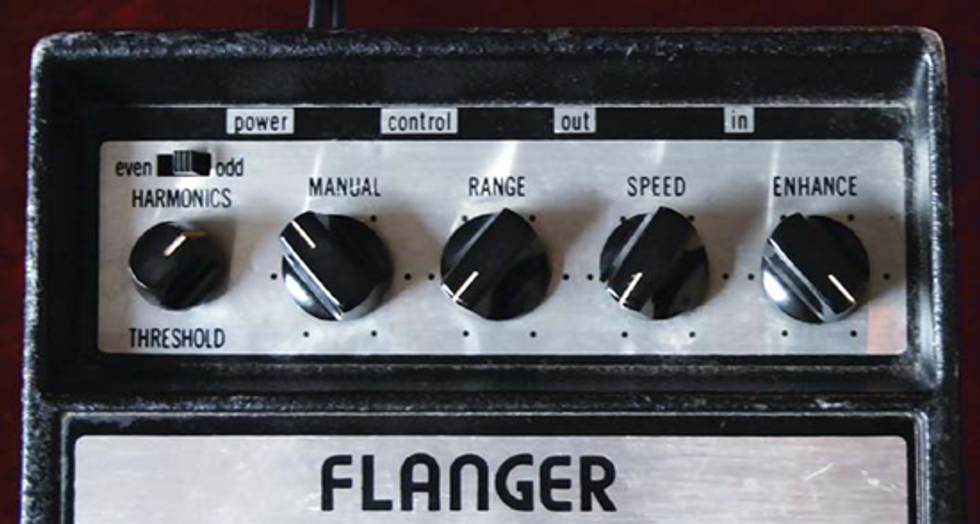Back by popular demand, this month’s edition of “Stomp School” is dedicated to answering questions sent to us by you, the readers of this column. If you have any questions for us, please feel free to send them to stompschool@formusiciansonly.com, and we’ll do our best to answer them. Okay, let’s get started.
Q: I have an A/DA Flanger that I got recently. It’s the model with the AC cord, as opposed to a wall wart. At some point, it was modified to have a dry output. I am trying to figure out the function of the Manual knob. It seems to have little effect on the sound when I turn it. Is this normal, or is it possible that the Manual knob is not working properly? Thanks for any help you can provide.
 Tom’s A/DA Flanger, “Steel Drum Setting.” Photo by Tom Hughes |
A: The best way to hear what the Manual knob does on the A/DA Flanger is to turn the Range knob (depth) all the way counterclockwise so it’s off. This will freeze the LFO, so the effect doesn’t sweep. Try turning the Enhance knob (feedback) all the way up to make the effect more dramatic. Now turn the Manual knob while you’re playing. It should manually sweep the range of the flanger. This has become a fairly common feature on many flangers, such as the MXR Flanger. One of the things that sets the A/DA apart is the addition of an expression pedal jack, which will allow you to do the manual sweep with a pedal. One of my favorite settings on the A/DA Flanger is the one described above, as it produces an excellent “steel drum” guitar sound. The Manual knob allows you to dial in a wide palate of metallic timbres. You can get a similar effect from most any flanger with this feature, but none of them nail the steel drum sound quite like the A/DA. If you’re not getting a sound similar to what’s been described, then it may be that something isn’t working properly, possibly due to the modification you mentioned.
Q: Hi, I need an adapter for my vintage Ibanez AD9 delay pedal. Regular aftermarket transformers made the ones I used to have buzz like crazy.
A: The buzz you’re hearing is most likely a 60Hz AC hum. Using a cheap, generic wall-wart can allow noise and hum in your signal. You need to use a good quality power supply made specifically for audio equipment that has noise filtering and voltage regulation. The Boss 9V PSA adapters are a good choice for the AD9 and most vintage effects. Dunlop, Danelectro, and Electro-Harmonix also make power adapters designed specifically for pedals. The Dunlop comes with a Boss-style barrel plug, or the 1/8" pin-type, like an old MXR or Electro-Harmonix effect.
If you have several pedals that you need to power, you should definitely consider something like the Voodoo Labs Pedal Power 2 Plus or T-Rex Fuel Tank, each of which will give you up to eight isolated power outlets. If budget is a concern, you can try a daisychain type power supply like the Godlyke Power-All or Visual Sound 1 Spot. Whatever you choose, nearly any music store you go to will have something available that’s designed for pedals.
Q: Last month, I purchased a Marshall Echohead delay pedal. Three days later it took a massive dump. The only other pedal I used in the chain was a DigiTech Death Metal distortion. This setup worked and sounded killer for two days. The third day, I put some Danelectro 9V batteries in the Echohead. The result was a horrible popping and squealing sound, and ultimately the death of the pedal. The guy at the local guitar shop said the pedal blew up simply because I ran a distortion into a delay pedal. I have been told conflicting information ever since this happened. I now run the DigiTech into a TC Electronic Nova Delay, and so far I’ve had no problems at all. Yes, I still run it this way despite what some people say, because it sounds astronomically better. What are your thoughts on this matter?
A: That’s really strange, on a lot of levels. A distortion pedal should not be able to actually damage a delay pedal unless something is wrong with one of the pedals. It would sound very bad when you played, for a long time, well before any damage could be done. This sounds like a fluke. We weren’t really sure how to answer this one, but we will say the info you got at the guitar shop is highly suspect. Try referring to our January column for tips on troubleshooting your pedal problems.
Well, that’s all for now. Check back with us again next month for more “Stomp School” Q & A. Until then, keep on stompin’!
Tom Hughes
(a.k.a. Analog Tom) is the owner and proprietor of For Musicians Only (formusiciansonly.com) and author of Analog Man’s Guide To Vintage Effects. Questions or comments about this article can be sent to: stompschool@formusiciansonly.com.
Analog Man
(analogman.com) is one of the largest boutique effects manufacturers and retailers in the business, established by “Analog” Mike Piera in 1993. Mike can be reached at AnalogMike@aol.com.







![Rig Rundown: Russian Circles’ Mike Sullivan [2025]](https://www.premierguitar.com/media-library/youtube.jpg?id=62303631&width=1245&height=700&quality=70&coordinates=0%2C0%2C0%2C0)

















